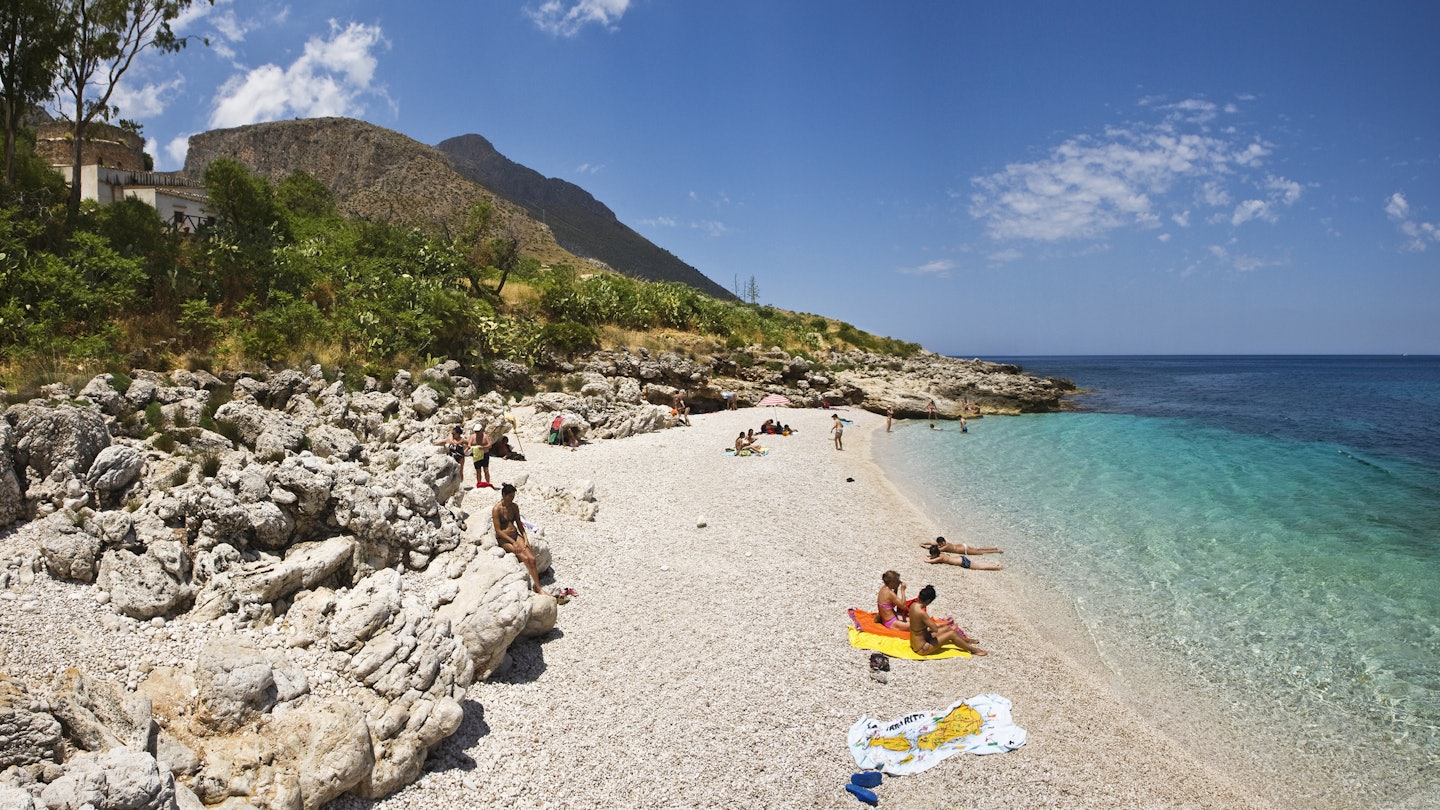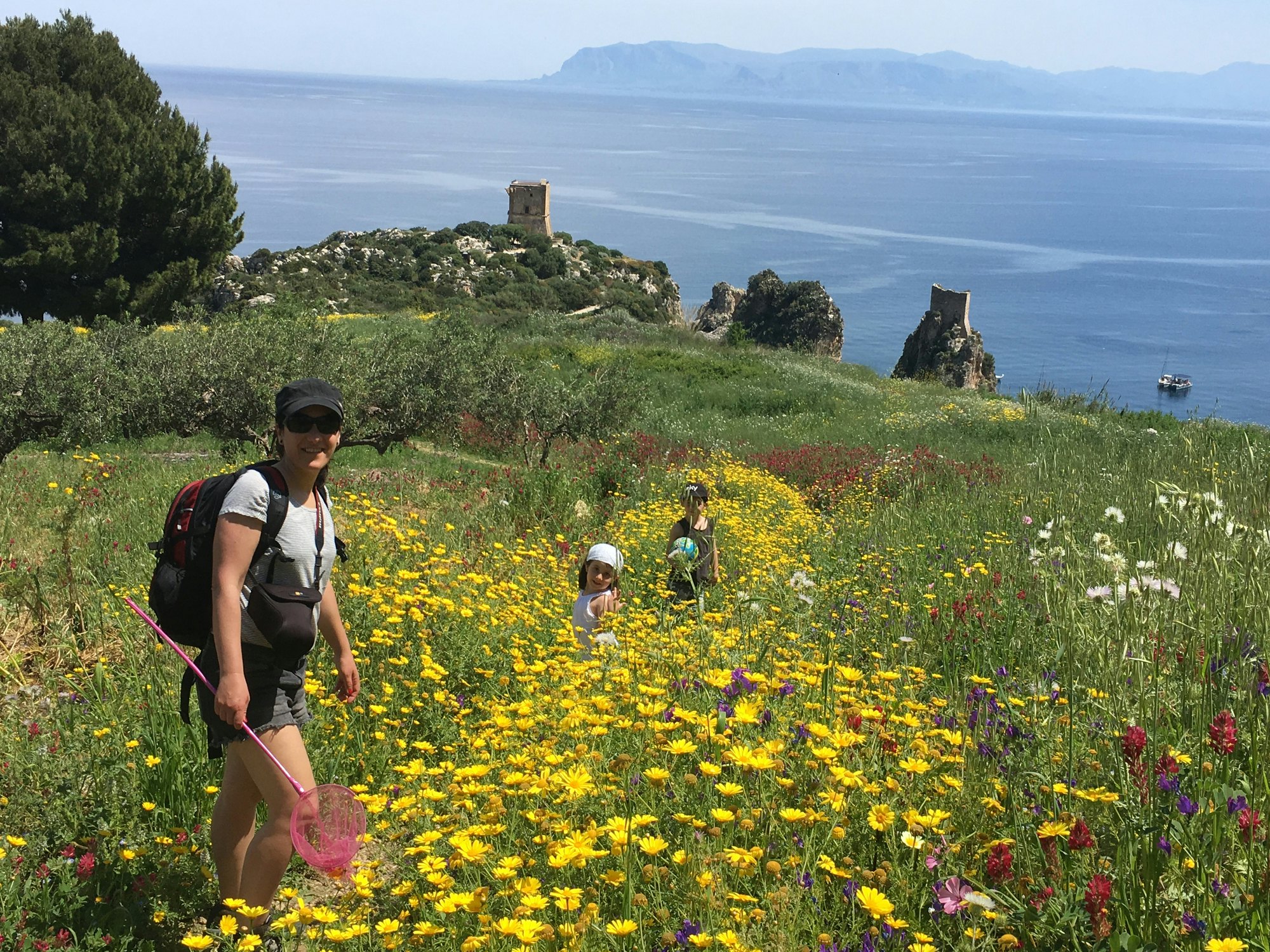Sicily's most beautiful national parks and reserves
Nov 25, 2021 • 5 min read

Sunbathers relaxing on a beach at Zingaro Natural Reserve © Getty Images
Sicily's most inspiring natural beauty spots are protected by numerous parks and reserves that dot the island. Walking trails abound in the parks and you can visit isolated beaches, pristine forests and active volcanoes.
Plus you can spot all manner of local wildlife and visit traditional villages where life is little-changed in decades. Here are eight of our favorite parks for exploring the natural world in Sicily.
Parco Naturale Regionale delle Madonie
Best for traditional villages
The 400 sq km (154 sq mi) Madonie regional park is an outdoor paradise that’s well suited to slow, culturally rich travel. The Madonie Mountains are crowned by Pizzo Carbonara, which is the highest mountain in Sicily after Mt Etna.
Spring here sees spectacular spreads of wildflowers carpeting the mountain slopes; autumn brings wild mushrooms and richly colored foliage; winter draws snow sports enthusiasts and summer offers an escape from the coastal crowds.
This is not just a nature reserve but an area where people live and work, so you can combine hiking with visits to historic hilltop towns. Castelbuono, the charming capital of the Madonie is set amid ancient manna ash and chestnut forests. A 15th-century castle dominates the town’s skyline.

Parco Nazionale Isola di Pantelleria
Best for isolation
One of Sicily’s national parks is halfway to Tunisia. A volcanic outcrop, Pantelleria is Sicily’s largest offshore island. It’s characterized by jagged lava rock formations, steaming fumaroles and mudbaths. The island’s unique agricultural traditions, featuring dwarf grapevines and olive trees laid out on terraces between dry stone walls, earned it Unesco World Heritage status in 2014. There are no true beaches, but Pantelleria’s gorgeous, secluded coves are perfect for snorkeling, diving and boat excursions.
The park protects over 80% of the island, including the unique dammusi – lava rock houses with thick, whitewashed walls and shallow cupolas. Exotic and remote, Pantelleria has long been an escape for top celebrities. It can be reached by ferry and plane.
Parco dell’Etna
Best for volcanic drama
Dominating the landscape of eastern Sicily, Mt Etna is a massive brooding presence. At 3357m (11,013ft) it is Italy’s highest mountain south of the Alps and the largest active volcano in Europe. It’s in an almost constant state of activity and eruptions occur frequently, most spectacularly from the four summit craters, but more often, and more dangerously, from the fissures and old craters on the mountain’s flanks.
The volcano and its slopes comprise the Parco dell’Etna. Encompassing 580 sq km (224 sq mi) and some 21 towns, the park’s varied landscape ranges from the severe, snowcapped mountain top to lunar deserts of barren black lava, beech woods and lush vineyards.
Good bases for exploring Mt Etna include the gritty, medieval port city of Catania and the center of Sicily’s posh summertime society, Taormina.

Parco Regionale dei Nebrodi
Best for solitude
Encompassing the Nebrodi Mountains of northeastern Sicily, the Parco Regionale dei Nebrodi constitutes the single largest forested area in Sicily. It’s dotted with remote and traditional villages that host few visitors.
This lovely, off-the-beaten-track park encompasses an undulating landscape of beech, oak, elm, ash, cork, maple and yew trees that shelter the remnants of Sicily’s wildlife: porcupines, San Fratello horses and wildcats, as well as a healthy population of birds including golden eagles, herons and peregrine falcons. The high pastures are home to farms growing mushrooms and hazelnuts.
With your own vehicle, you can explore the timeless villages and access trailheads that plunge into the forest. Located on the park’s western border, Mistretta is a charming hilltop time capsule where the streets have hardly changed in 300 years.
Riserva Naturale dello Zingaro
Best for nature lovers
The tranquil Riserva Naturale dello Zingaro is the star attraction on the Golfo di Castellammare, drawing nature lovers and outdoors enthusiasts. It’s a hiker’s paradise and a haven for wildlife, including some 40 bird species. Wild carob and bright-yellow euphorbia dust the hillsides, along with 700 other species of Mediterranean plants, while hidden coves provide tranquil swimming and snorkeling spots.
From the main coastal path, well-signposted gravel tracks cut through aromatic scrub and broom, almond trees and meadows to picturesque coves with pretty beaches. Only accessible by boat or on foot, top choices include Cala Capreria, with bright turquoise water and ample rocks to laze on, near the park’s southern Scopello entrance; and family-friendly Cala della Disa. Snorkelers favor Cala Marinella for its piercing emerald-green waters, accessed from rocks (there is no beach as such).
The park can be easily reached in under an hour from Palermo.
Riserva Naturale Saline di Trapani e Paceco
Best for bird-watching
Administered by the World Wildlife Fund, this vital bird sanctuary protects 10 sq km of saline (salt pans), divided into two zones, extending from Trapani’s southern outskirts to the hamlet of Saline Grande.
With a couple of weeks’ advance notice, WWF guides can sometimes offer free two-hour tours of the reserve, focusing on migratory waterfowl in spring and fall. In summer, they’ll take you to see the salt harvest.
Besides this reserve near Trapani, the salt pans are also protected by the Riserva Naturale di Stagnone to the south near Marsala. The latter includes San Pantaleo island, home to the noted Phoenician archaeological site of Mozia.

Parco Minerario Floristella Grottacalda
Best for history
The historic remains of sulfur mining that was active in Central Sicily until the mid-20th century are now hidden amidst this pleasantly verdant and forested park. A poignant reminder of the industry’s harsh realities is the black-and-white photography in the park’s compelling museum, showing child miners forced to work in very dangerous conditions. It’s a stark reminder of how poverty has shaped Sicily’s history.
The park is about 15km (9.3 mi) north of Piazza Armerina, an unmissable medieval labyrinth and a good base for the region.
Riserva Naturale Torre Salsa
Best for walking
With your own wheels, you’ll find some stunning beaches and beauty spots west of Agrigento. This includes Riserva Naturale Torre Salsa, a beautiful 7.6 sq km (2.9 sq miles) nature park administered by the World Wildlife Fund.
The site offers plenty of scope for walkers, with well-marked trails and sweeping panoramic views of the surrounding mountains and coast. The long, deserted Torre Salsa beach is especially beautiful and the rough access road keeps the people count low. (Nearby Siculiana Marina has its own great sandy beach.) The beach is reached from the reserve’s northern entrance, which in turn is under 45 minutes from Agrigento. The city makes a fine base for exploring the rest of the region as well, including the world-renowned Valley of Temples.
You might also like:
Why Sicily is a year-round destination
15 things you cannot miss on your next trip to Sicily
The best free things to do in Sicily: from stunning churches to sumptuous art
Plan with a local




